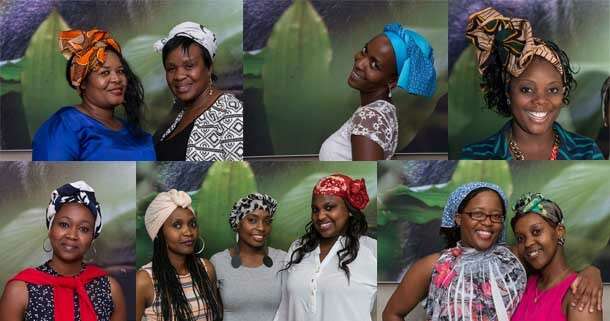Rukariro Katsande elaborates on our often beautifully adorned and colourful head wraps which continue to hold symbolic significance in Africa…

A head wrap or head scarf is a very common accessory among women in many parts of Africa and abroad. Some make the historical link of origins to royalty in ancient Egypt, Nubia and West Africa. Hieroglyphic evidence points to Pharaohs who wore headbands or covered their hair with wigs. The divine crowns for royalty and gods were made of cloth and had specific meaning and significance (1). In other parts of Africa hair wigs were made of natural materials such as beads, feathers and plant fibres from the baobab tree. Traditionally some wigs were covered with ochre, animal fat and decorated with beads, buttons and shells (2).

Here in southern Africa, the name used is influenced by the Afrikaans name for cloth which is “doek”. Hence across various countries this name has been adapted to suit local languages and dialects.
• Botswana – Tukwi/tuku
• Malawi – Duku
• South Africa – Doek
• Zimbabwe – Dhuku
• Zambia – chitambala
Although the head-wrao is mostly seen on married and elderly women in rural and some urban settings, it has developed into a popular, ornamental head covering and fashion accessory even among the youth. Its uses and, of course, meanings vary greatly depending on the country and culture of those who wear it. Some men see head wraps as exclusively for women only, although there do exist other forms of headgear for men. Interestingly traditional Zulu men were weavers of headgear for their culture, but by the mid-1900s many were working in the mines and the task became womens’ work.

In northern Africa, head ties are worn for day to day activities, elaborate ceremonial occasions and spiritual worship. A renaissance in African pride has seen many of the head ties worn up north being now worn to signify affluence as well as spirituality in black women. These are generally bigger in size and more elaborate in design than the ones worn down here in the south. The ones worn in southern Africa are smaller and much more conservative. These are worn tied upwards or downwards depending on the occasion and also during sleep to protect hair.
For rural women head wraps are often used as protective clothing to cover hair from dust and dirt while doing chores. Many urban youth associate head ties with a submissiveness which is much frowned upon in contemporary feminist theory; imagery described is homemakers who wear hair rollers or elderly women. Newly married young women in African culture receive head ties (like the sarong) especially from mother-in-laws to denote respect and an achievement of respectable status. Today the head wraps are usually accompanied by traditional or matching attire that may or may not have the same pattern or colours as the head tie.

In Africa in general, and universally in some houses of worship, women (for example ZCC) are often required to wear head ties to cover their heads as a sign of respect and humility. As in medieval Europe, in a majority of African communities it is shocking for a grown woman to show her hair. In Arles France, between 1162 and 1202, a law was passed that forbade women of ill-repute to wear head veils, just in case they were mistaken for virtuous women. The public was encouraged to snatch any veils off the heads of suspected immoral women (3). I imagine one would not receive a mild reaction if this was to happen in Africa…
Traditional Jewish women cover their hair with a tichel or snood. Rastafarians wear turbans over their dreadlocks for protection against the environment, religious purposes and again for respect and humility – as with the Ethiopian Muslim who wears a hijab or khimar. The European equivalent would be a wimple, which was worn by married or well-groomed women, and more commonly today by some nuns who still don the habit.
In Christianity there are no direct divine commands for women to cover their heads, however Bible verses can be found that showed a level of modesty and this practice: Genesis 24:65, Numbers 5:18. In the New Testament can be found more direct guidance as to practices to be followed at Corinthians 11:2-16. Generally the requirement for religious purposes has become more lenient with the proliferation of denominations.
Beautifully adorned and colourful head ties will continue to give meaning, and hold symbolic significance for time to come in Africa – as a means to uplift and continue an ancient heritage, status and fashion statement.
References and further reading:
(1) http://www.quora.com/What-is-the-name-of-an-Egyptian-headdress-worn-by-Pharoahs
(2) http://www.ezakwantu.com/Gallery%20African%20Headdresses%20-%20Wigs.htm
(3) Gilbert R, “Medieval Veils, Wimples and Gorgets” http://rosaliegilbert.com/veilsandwimples.html
http://www.ezakwantu.com/Gallery%20African%20Headdresses%20-%20Wigs.htm

Let’s plan your next journey
Ready?
When we say we’re there every step of the way, we mean it, literally. From planning the perfect circuit, to private inter-camp transfers on Wilderness Air, and easing you through Customs. We’re with you on the ground, at your side, 24-7, from start to finish. Ready to take the road less travelled? Contact our Travel Designers to plan an unforgettable journey.